Mining Prediction Based on the Coupling of Structural-Alteration Anomalies in the Tsagaankhairkhan Copper–Gold Mine in Mongolia Through the Collaboration of Multi-Source Remote Sensing Data
Abstract
1. Introduction
2. Overview of the Study Area
2.1. Geographic Location
2.2. Regional Geological Background
2.2.1. Geological Background of Mongolia
2.2.2. Geological Background of the Tsagaankhairkhan Copper–Gold Mining Area
3. Data Sources and Preprocessing
3.1. Data Sources
3.2. Data Preprocessing
3.2.1. Multi-Source Remote Sensing Data Preprocessing
3.2.2. Enhancement of Geological Structure Interpretation Features
3.2.3. Mineral Alteration Information Extraction and Interference Information Removal
4. Remote Sensing Geological Structure Interpretation
4.1. Linear Structure Interpretation
4.2. Interpretation of Circular Structures
4.3. Geological Structure Interpretation Results and Analysis
5. Alteration Information Extraction
5.1. Spectral Feature Analysis of Alteration Minerals
5.2. Principal Component Analysis (PCA)
5.3. Extraction Results and Analysis of Alteration Information
5.3.1. Extraction of Hydroxyl Alteration from Sentinel-2 and Landsat-8
5.3.2. Landsat-8 and Sentinel-2 Iron-Staining Alteration Extraction
5.4. Anomaly Classification
5.4.1. Hydrolysis Alteration Anomaly Classification
5.4.2. Iron-Staining Alteration Anomaly Classification
5.5. Evaluation of Alteration Anomaly Information Extraction Effect
6. Delimitation of Mineralization Target Areas and Mineralization Prediction
7. Field Verification
8. Conclusions
Author Contributions
Funding
Institutional Review Board Statement
Informed Consent Statement
Data Availability Statement
Acknowledgments
Conflicts of Interest
References
- Liang, S.; Wei, H.; Gan, F.; Chen, L.; Xiao, C. Preliminary Application Evaluation of GF-2 Satellite Data in Remote Sensing Geological Survey. Spacecr. Recovery Remote Sens. 2015, 36, 63–72. [Google Scholar]
- Pei, Q.; Shen, J.; Wang, S.; Fang, D.; Gao, Y.; Li, D.; Ma, S. Exploring Luorite Veins Using Multi-source Remote Sensing Astellite Data: A Case Study from theShuitou Fluorite Deposit in Inner Mongolia, China. Northwestern Geol. 2024, 57, 121–134. [Google Scholar]
- Vincent, R.K. Spectral ratio imaging methods for geological remote sensing from aircraft and satellites. In Proceedings of the Management Utilization of Remote Sensing Data Conference, Sioux Falls, SD, USA, 31 October 1973. [Google Scholar]
- Tangestani, M.H.; Moore, F. Comparison of three principal component analysis techniques to porphyry copper alteration mapping: A case study, Meiduk area, Kerman, Iran. Can. J. Remote Sens. 2001, 27, 176–182. [Google Scholar] [CrossRef]
- Loughlin, W. Principal component analysis for alteration mapping. Photogramm. Eng. Remote Sens. 1991, 57, 1163–1169. [Google Scholar]
- Crósta, A.P.; De Souza Filho, C.R.; Azevedo, F.; Brodie, C. Targeting key alteration minerals in epithermal deposits in Patagonia, Argentina, using ASTER imagery and principal component analysis. Int. J. Remote Sens. 2003, 24, 4233–4240. [Google Scholar] [CrossRef]
- Shahriari, H.; Honarmand, M.; Ranjbar, H. Comparison of multi-temporal ASTER images for hydrothermal alteration mapping using a fractal-aided SAM method. Int. J. Remote Sens. 2015, 36, 1271–1289. [Google Scholar] [CrossRef]
- Honarmand, M.; Ranjbar, H.; Shahriari, H.; Naseri, F. Evaluating the effect of using different reference spectra on SAM classification results: An implication for hydrothermal alteration mapping. J. Min. Environ. 2018, 9, 981–997. [Google Scholar]
- Pour, A.B.; Zoheir, B.; Pradhan, B.; Hashim, M. Editorial for the Special Issue: Multispectral and Hyperspectral Remote Sensing Data for Mineral Exploration and Environmental Monitoring of Mined Areas. Remote Sens. 2021, 13, 519. [Google Scholar] [CrossRef]
- Gabr, S.; Ghulam, A.; Kusky, T. Detecting areas of high-potential gold mineralization using ASTER data. Ore Geol. Rev. 2010, 38, 59–69. [Google Scholar] [CrossRef]
- Salehi, T.; Tangestani, M.H. Evaluation of WorldView-3 VNIR and SWIR Data for Hydrothermal Alteration Mapping for Mineral Exploration: Case Study from Northeastern Isfahan, Iran. Nat. Resour. Res. 2020, 29, 3479–3503. [Google Scholar] [CrossRef]
- Warner, T.A.; Skowronski, N.S.; Gallagher, M.R. High spatial resolution burn severity mapping of the New Jersey Pine Barrens with WorldView-3 near-infrared and shortwave infrared imagery. Int. J. Remote Sens. 2017, 38, 598–616. [Google Scholar]
- Zhang, W.; Jin, M.S.; Zhang, S.P.; Chen, L.; Zhong, C.; Dong, L.N. Application of high resolution remote sensing data to ore-prospecting prediction in East Kunlun metallogenic belt. Remote Sens. Land Resour. 2016, 28, 8. [Google Scholar]
- Sun, Y.B.; Wang, R.J.; Wei, B.Z.; Wang, B.; Dong, S.F.; Li, C.J.; Li, M.S. The application of hyperspectral remote sensing ground-air integrated prediction method to the copper gold deposit prospecting in Kalatag area, Xinjiang. Geol. China 2018, 45, 14. [Google Scholar]
- Li, H.W.; Zhao, Y.H.; Fang, Z.; Zheng, L.; Zhu, Y.P. Application of remote sensing technology in prospecting and exploration of porphyry copper-gold deposits in Mina Pirquitas, Northwest Argentina. Geol. Bull. China 2023, 43, 582–593. [Google Scholar]
- Moradpour, H.; Paydar, G.R.; Pour, A.B.; Kamran, K.V.; Hossain, M.S. Landsat-7 and ASTER remote sensing satellite imagery for identification of iron skarn mineralization in metamorphic regions. Geocarto Int. 2020, 37, 1971–1998. [Google Scholar] [CrossRef]
- Mars, J.C. Mineral and Lithologic Mapping Capability of WorldView 3 Data at Mountain Pass, California, Using True- and False-Color Composite Images, Band Ratios, and Logical Operator Algorithms. Econ. Geol. Bull. Soc. Econ. Geol. 2018, 113, 1587–1601. [Google Scholar]
- Amraoui, T.; Ibouh, H.; Farah, A.; Bammou, Y.; Shebl, A. Remote sensing mapping of structural and hydrothermal alteration in the mougueur inlier, Eastern high atlas, Morocco. Sci. Rep. 2025, 15, 14982. [Google Scholar] [CrossRef]
- Zhong, F.J.; Pan, J.Y.; Liu, X.S.; Zhang, Y.; Liu, G.Q.; Liu, Y. A Metallogenic Model Based on Comprehensive Information and Genesis Analysis for the Houerdaogou Copper-Gold Deposit in Inner Mongolia. Geol. Explor. 2014, 3, 432–444. [Google Scholar]
- Gao, K.; Duo, J.; Tang, J.X.; Zhang, Z.; Song, J.L.; Ding, S.; Song, Y.; Lin, B.; Feng, J. Alteration of Naruo Porphyry Cu (Au) Deposit in the Duolong Ore-concentration Area, Tibet. Bull. Mineral. Petrol. Geochem. 2016, 35, 1226–1237. [Google Scholar]
- Li, K.; Wang, G.W.; Chen, Y.Q.; Hao, Y.L.; Ma, M.; Zhu, Y.Y. The application of comprehensive geological information of remotesensing and metallogenic model to the prognosis of porphyry copper-gold deposits in Papua New Guinea. Geol. Bull. China 2015, 34, 6. [Google Scholar]
- Farahbakhsh, E.; Goel, D.; Pimparkar, D.; Muller, R.D.; Chandra, R. Convolutional neural networks for mineral prospecting through alteration mapping with remote sensing data. Remote Sens. Geoinf. Sci. 2025, 93, 379–400. [Google Scholar] [CrossRef]
- Wang, Q.; Tang, J.X.; Chen, Y.C.; Hou, J.F.; Li, Y.B. Mineralization Model and Exploration Directions of the Tibet Duolong Super-Large Copper (Gold) Mineralization District. Acta Petrol. Sin. 2019, 35, 18. [Google Scholar]
- Rajesh, H.M. Application of remote sensing and GIS in mineral resource mapping—An overview. J. Mineral. Petrol. Sci. 2004, 99, 83–103. [Google Scholar] [CrossRef]
- Booysen, R.; Gloaguen, R.; Lorenz, S.; Zimmermann, R.; Nex, P.A.M. The Potential of Multi-Sensor Remote Sensing Mineral Exploration: Examples from Southern Africa. In Proceedings of the IEEE International Symposium on Geoscience and Remote Sensing (IGARSS), Yokohama, Japan, 28 July–2 August 2019. [Google Scholar]
- Booysen, R.; Zimmermann, R.; Lorenz; Gloaguen, R.; Mckel, R. Towards Multiscale and Multisource Remote Sensing Mineral Exploration Using RPAS: A Case study in the Lofdal Carbonatite-Hosted REE Deposit, Namibia. Remote Sens. 2019, 11, 2500. [Google Scholar] [CrossRef]
- Sikakwe, G.U. Mineral exploration employing drones, contemporary geological satellite remote sensing and geographical information system (GIS) procedures: A review. Remote Sens. Appl. Soc. Environ. 2023, 31, 100988. [Google Scholar] [CrossRef]
- Lei, L.; Jun, Z.; Dong, J.; Dafang, Z.; Lamin, M.; Bing, Z. Targeting Mineral Resources with Remote Sensing and Field Data in the Xiemisitai Area, West Junggar, Xinjiang, China. Remote Sens. 2013, 5, 3156–3171. [Google Scholar]
- Gerel, O.; Pirajno, F.; Batkhishig, B.; Dostal, J. Mineral Resources of Mongolia; Springer: Singapore, 2021; Volume 461. [Google Scholar]
- Zhang, Q.H. Geography of Mineral Resources in Mongolia; Yellow River Publishing House: Zhengzhou, China, 2016. [Google Scholar]
- Roy, D.P.; Wulder, M.A.; Loveland, T.R.; Woodcock, C.E.; Zhu, Z. Landsat-8: Science and product vision for terrestrial global change research. Remote Sens. Environ. 2014, 145, 154–172. [Google Scholar] [CrossRef]
- Chen, Q.; Xia, J.; Zhao, Z.; Zhou, J.; Zhu, R.; Zhang, R.; Zhao, X.; Chao, J.; Zhang, X.; Zhang, G. Interpretation of hydrothermal alteration and structural framework of the Huize Pb–Zn deposit, SW China, using Sentinel-2, ASTER, and Gaofen-5 satellite data: Implications for Pb–Zn exploration. Ore Geol. Rev. 2022, 150, 105154. [Google Scholar] [CrossRef]
- Franks, S.; Rengarajan, R. Evaluation of Copernicus DEM and Comparison to the DEM Used for Landsat Collection-2 Processing. Remote Sens. 2023, 15, 2509. [Google Scholar] [CrossRef]
- Wang, Q.; Shi, W.; Li, Z.; Atkinson, P.M. Fusion of Sentinel-2 images. Remote Sens. Environ. 2016, 187, 241–252. [Google Scholar] [CrossRef]
- Sun, Y.; Tian, S.; Di, B. Extracting mineral alteration information using WorldView-3 data. Geosci. Front. 2017, 8, 1051–1062. [Google Scholar] [CrossRef]
- Zhang, B.; Zhang, Z.; Shuai, S.; Zhang, Y.M. Lithlogical Mapping by Using the Synergestic Landsat-8 and Worldview-2 Images. Geol. Sci. Technol. Inf. 2015, 34, 7. [Google Scholar]
- Ali, M.I.; Dirawan, G.D.; Hasim, A.H.; Abidin, M.R. Detection of Changes in Surface Water Bodies Urban Area with NDWI and MNDWI Methods. Int. J. Adv. Sci. Eng. Inf. Technol. 2019, 9, 946. [Google Scholar] [CrossRef]
- Zhao, Z.F. Research on Mineralization Remote Sensing Anomaly Information; Geological Publishing House: Beijing, China, 2008. [Google Scholar]
- Govil, H.; Gill, N.; Rajendran, S.; Santosh, M.; Kumar, S.J.O.G.R. Identification of new base metal mineralization in Kumaon Himalaya, India, using hyperspectral remote sensing and hydrothermal alteration. Ore Geol. Rev. J. Compr. Stud. Ore Genes. Ore Explor. 2018, 92, 271–283. [Google Scholar] [CrossRef]
- Wang, D.; Chen, J.; Dai, X. Extracting geological and alteration information and predicting antimony ore based on multisource remote sensing data in Huangyangling, Xinjiang. Front. Earth Sci. 2024, 12, 1366727. [Google Scholar] [CrossRef]
- Pan, Z.; Liu, J.; Ma, L.; Chen, F.; Zhu, G.; Qin, F.; Zhang, H.; Huang, J.; Li, Y.; Wang, J. Research on Hyperspectral Identification of Altered Minerals in Yemaquan West Gold Field, Xinjiang. Sustainability 2019, 11, 428. [Google Scholar] [CrossRef]
- Shebl, A.; Abdellatif, M.; Badawi, M.; Dawoud, M.; Fahil, A.S.; Csámer, A. Towards better delineation of hydrothermal alterations via multi-sensor remote sensing and airborne geophysical data. Sci. Rep. 2023, 13, 7406. [Google Scholar] [CrossRef]
- Bao, Q.; Yang, P.; Zhou, Z.; Lei, L.; Xia, Q.; Liu, Y.; Gong, Y.; Lu, J. Integrated application of alteration information from Landsat8-OLI remotesensing images and geochemical singularity anomaly information for the Shuiyuesi area of western Hubei Province. Geophys. Geochem. Explor. 2024, 48, 1302–1312. [Google Scholar]
- Khaleghi, M. Synergetic use of the Sentinel-2, ASTER, and Landsat-8 data for hydrothermal alteration and iron oxide minerals mapping in a mine scale. Acta Geodyn. Geomater. 2020, 17, 311–328. [Google Scholar] [CrossRef]
- Elbakhouch, N.; Ibouh, H.; Touil, A.; Chafiki, D. Structural and mineralogical mapping using multispectral satellite data (Aster, Landsat 8 OLI, and Sentinel 2B) combined with field work in the Western High Atlas, Morocco. Geologos 2024, 30, 119–136. [Google Scholar] [CrossRef]
- Eldosouky, A.M.; Eleraki, M.; Mansour, A.; Saada, S.A.; Zamzam, S. Geological controls of mineralization occurrences in the Egyptian Eastern Desert using advanced integration of remote sensing and magnetic data. Sci. Rep. 2024, 14, 16700. [Google Scholar] [CrossRef] [PubMed]
- Mami Khalifani, F.; Lentz, D.R.; Walker, J.A.; Khammar, F. Applying Mineral System Criteria to Develop a Predictive Modelling for Epithermal Gold Mineralization in Northern New Brunswick: Using Knowledge-Driven and Data-Driven Methods. Minerals 2025, 15, 345. [Google Scholar] [CrossRef]


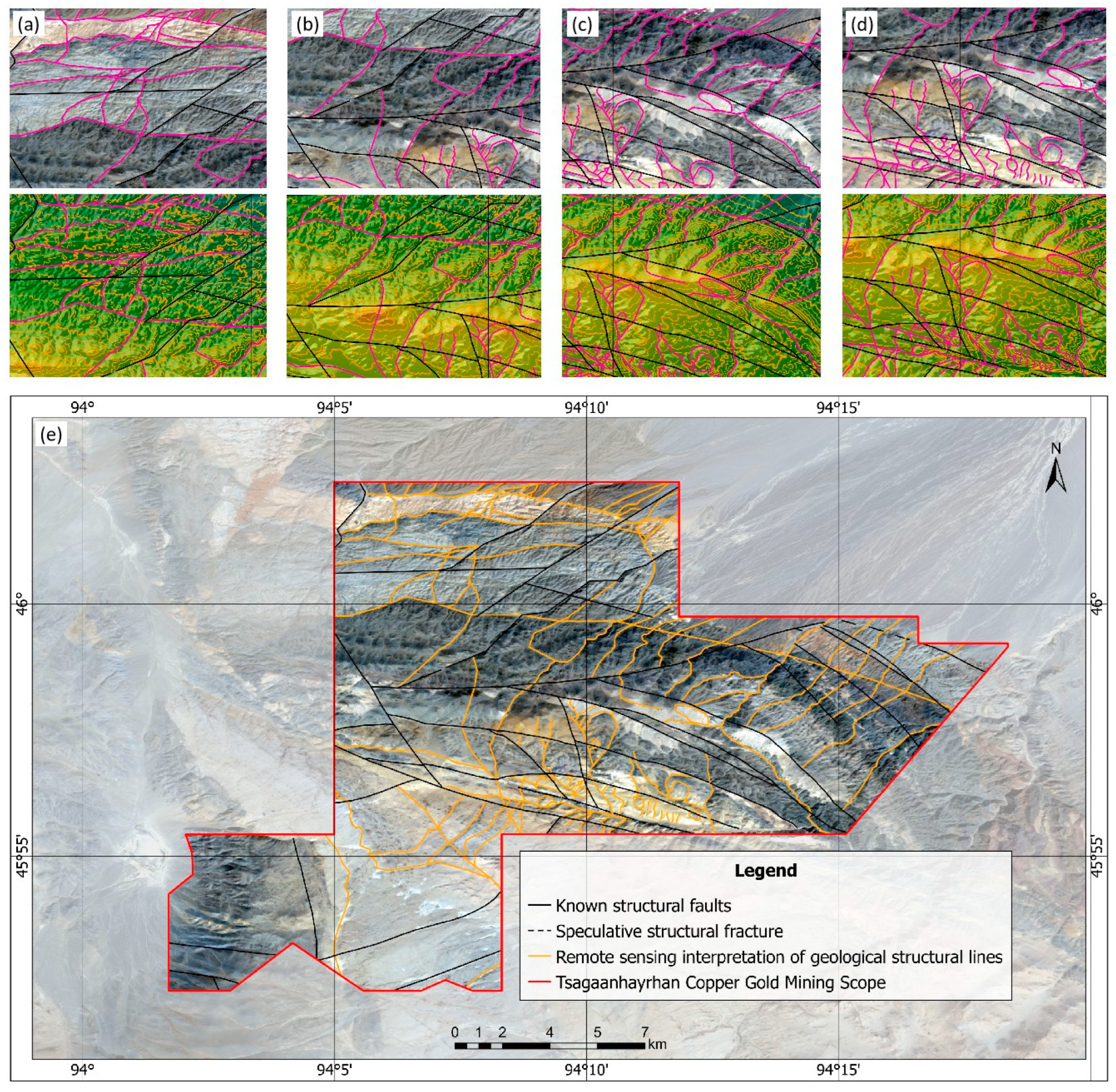
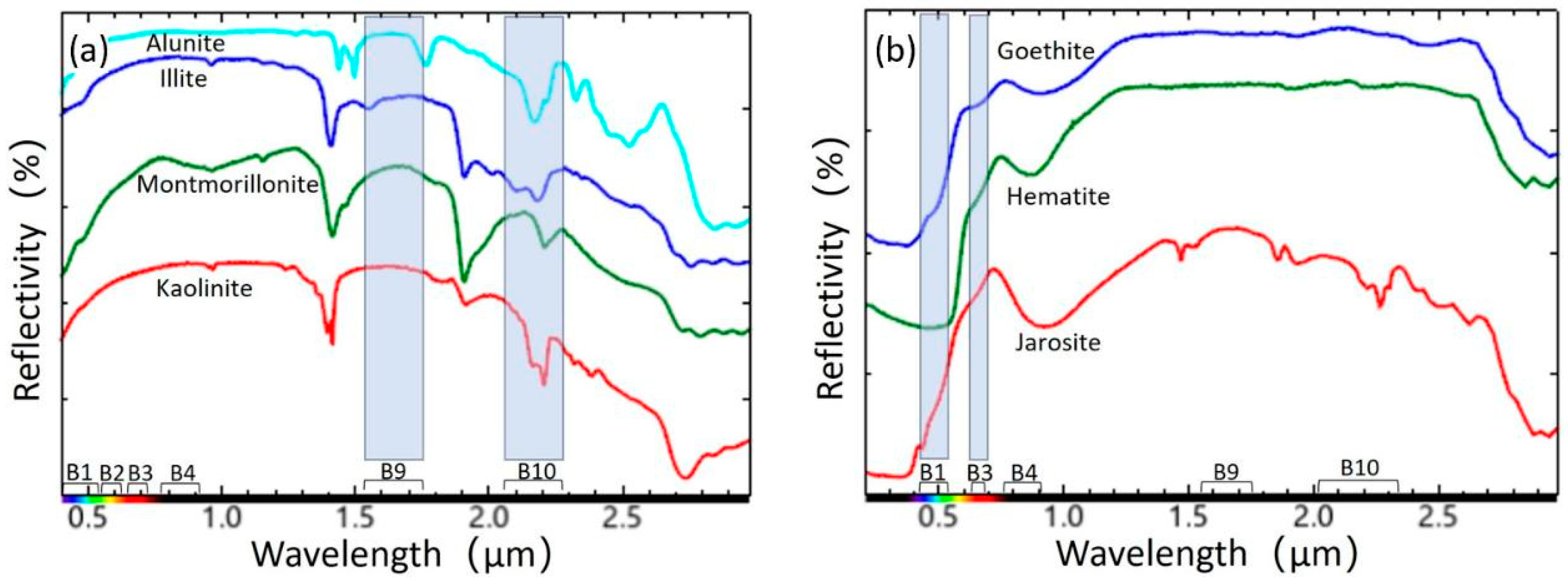
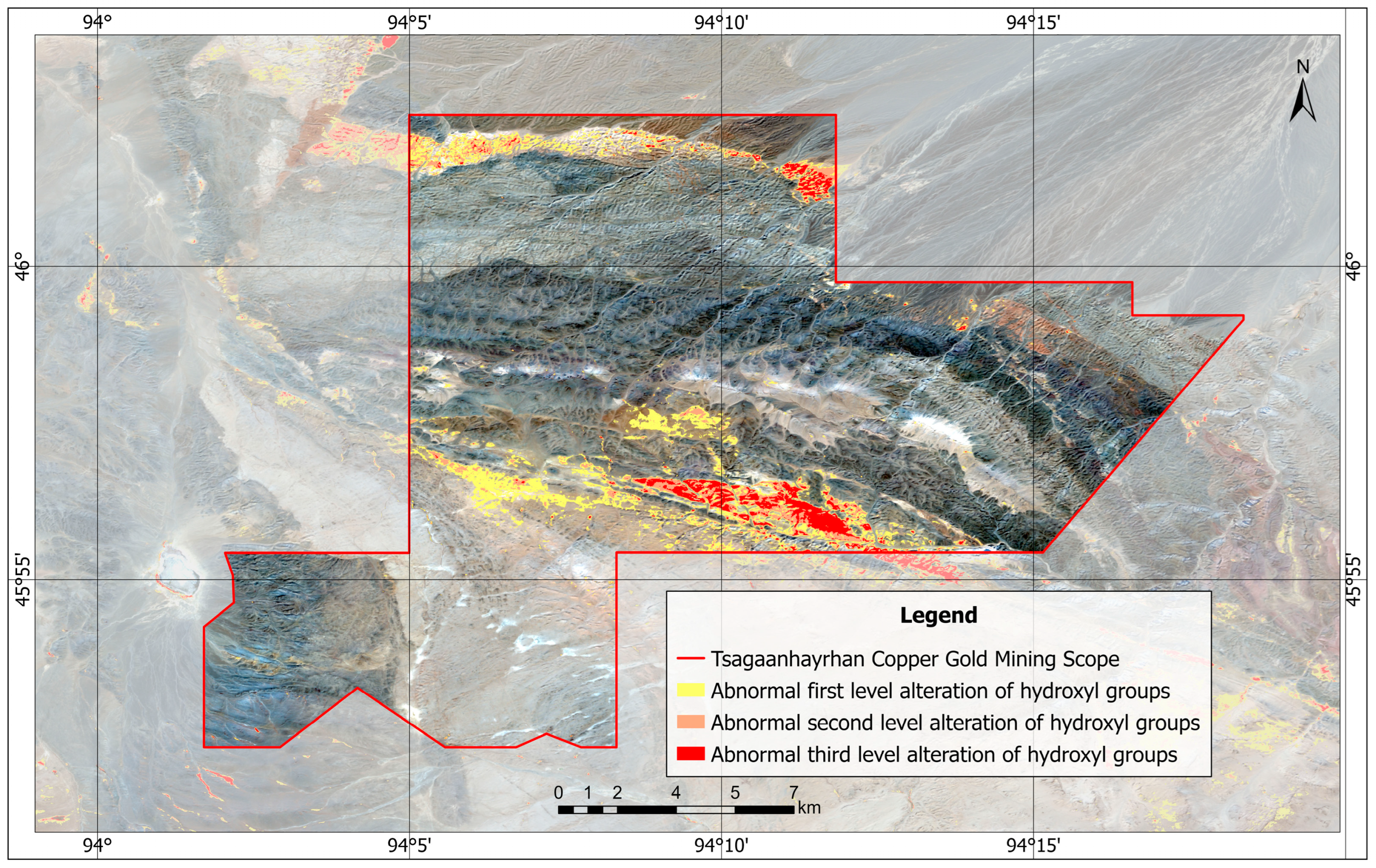
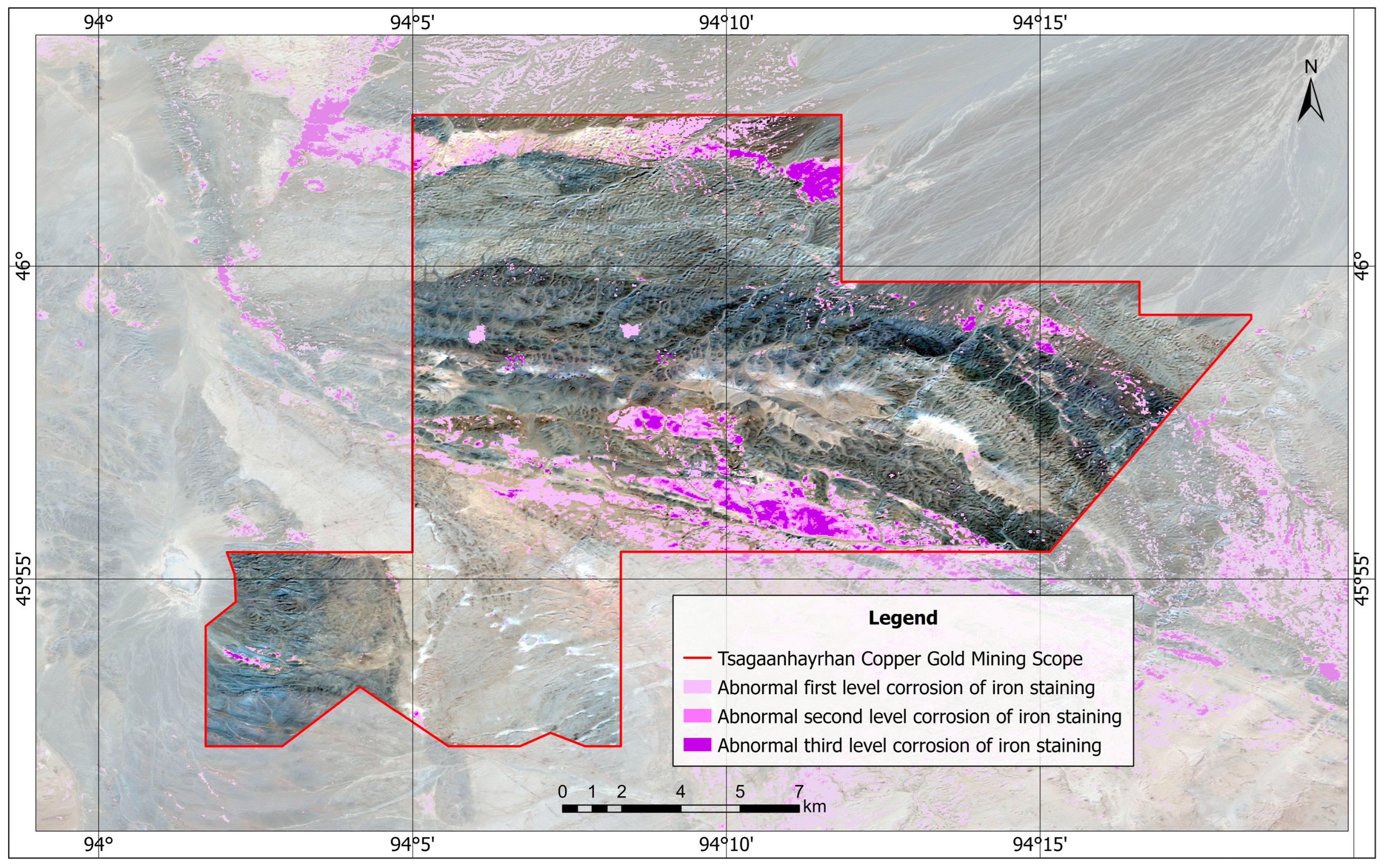

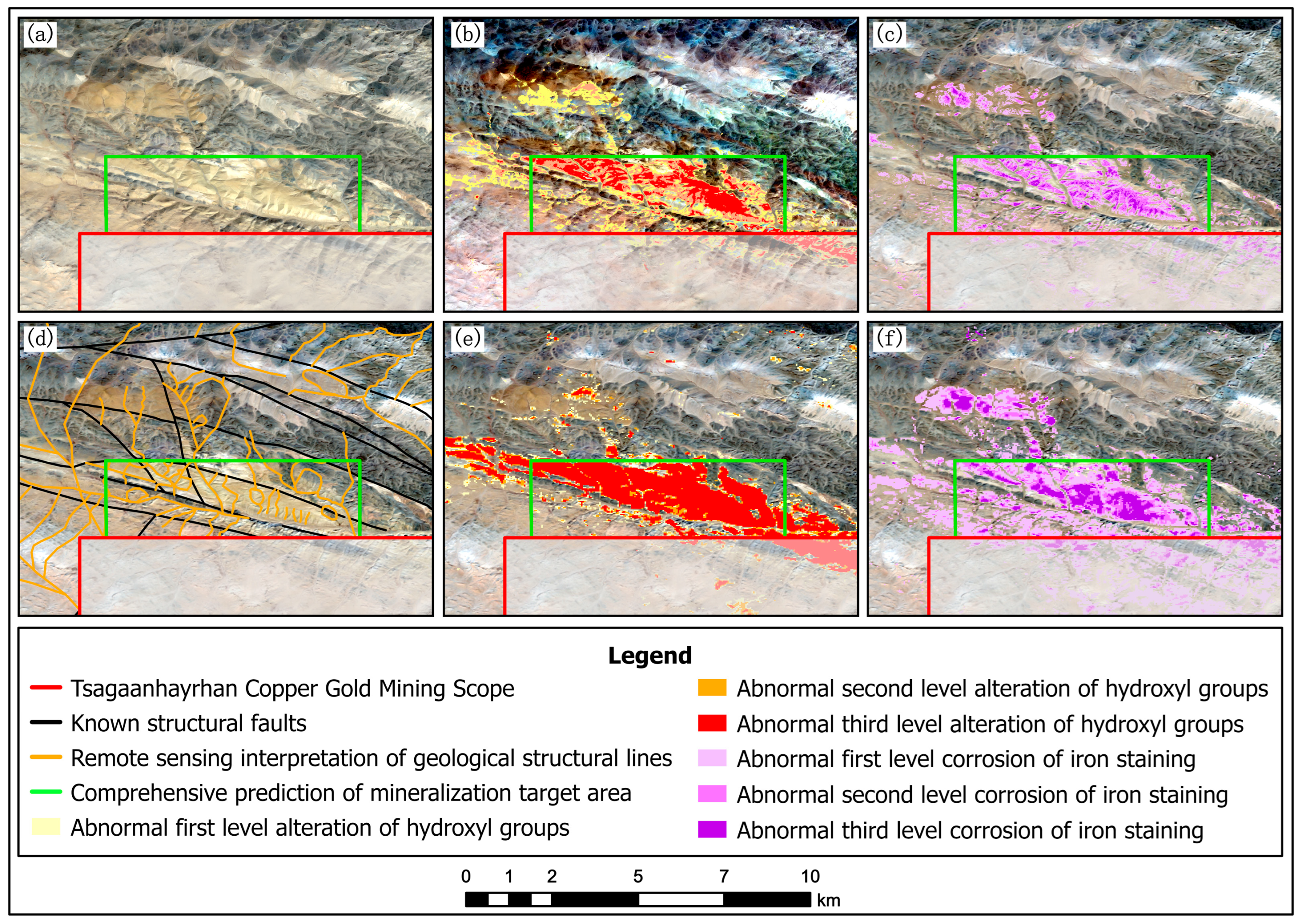

| Band | Wavelength/μm | Resolution/m | Detection Target |
|---|---|---|---|
| 1 | 0.433~0.453 | 30 | Mainly used for coastal zone observation |
| 2 | 0.450~0.515 | 30 | Used for water penetration, distinguishing soil vegetation, and identifying iron oxide in rocks |
| 3 | 0.525~0.600 | 30 | Vegetation growth status, distinguishing iron oxide rocks |
| 4 | 0.630~0.680 | 30 | In the chlorophyll absorption zone, used for observing bare soil, vegetation types, etc. |
| 5 | 0.845~0.885 | 30 | Estimating biomass, distinguishing wet soil, iron (III) oxide rocks, and concealed structures |
| 6 | 1.560~1.660 | 60 | Observing bare soil, water, identifying clouds and snow, and mineralization alteration zones |
| 7 | 2.100~2.300 | 30 | Rock types and hydrothermal alteration of rocks, identifying vegetation cover, and moist soil |
| 8 | 0.500~0.680 | 15 | 15 m resolution, used to enhance resolution |
| 9 | 1.360~1.390 | 30 | Includes strong absorption features of water vapor that can be used for cloud detection |
| Band Number | Wavelength (μm) | Resolution (m) | Main Application |
|---|---|---|---|
| B1 (Blue) | 0.45–0.52 | 4 | Enabling joint extraction of lithology, structures and alteration zones: the blue band detects iron stains, green–red banding discriminates carbonate/silicified zones, and the NIR band quantitatively inverts OH−/Fe3+ anomalies through vegetation; the panchromatic image finely traces faults, ring structures and mining facilities, supplying high-resolution “spatial–spectral” synergy for regional geological mapping, mineral prospecting and mine-environment monitoring. |
| B2 (Green) | 0.52–0.59 | 4 | |
| B3 (Red) | 0.63–0.69 | 4 | |
| B4 (NIR) | 0.77–0.89 | 4 | |
| Pan | 0.45–0.90 | 1 |
| Band Number | Band | Central Wavelength (μm) | Band Width (nm) | Spatial Resolution (m) |
|---|---|---|---|---|
| B1 | Coastal | 0.443 | 20 | 60 |
| B2 | Blue | 0.49 | 65 | 10 |
| B3 | Green | 0.56 | 35 | 10 |
| B4 | Red | 0.665 | 30 | 100 |
| B5 | Red edge 1 | 0.705 | 15 | 20 |
| B6 | Red edge 2 | 0.74 | 15 | 20 |
| B7 | Red edge 3 | 0.783 | 20 | 20 |
| B8 | NIR 1 | 0.842 | 115 | 10 |
| B8A | NIR 2 | 0.865 | 20 | 20 |
| B9 | Water vapor | 0.945 | 20 | 60 |
| B10 | Cirrus | 1.375 | 20 | 60 |
| B11 | SWIR 1 | 1.61 | 30 | 20 |
| B12 | SWIR 2 | 2.19 | 90 | 20 |
| Original Band Name | Fused Band Name | Central Wavelength (μm) |
|---|---|---|
| B2 | B1 | 0.492 |
| B3 | B2 | 0.559 |
| B4 | B3 | 0.665 |
| B8 | B4 | 0.833 |
| B5 | B5 | 0.704 |
| B6 | B6 | 0.739 |
| B7 | B7 | 0.780 |
| B8A | B8 | 0.864 |
| B11 | B9 | 1.610 |
| B12 | B10 | 2.185 |
| B1 | B11 | 0.442 |
| B9 | B12 | 0.943 |
| Band | B1 | B2 | B3 | B4 | B5 | B6 | B7 |
|---|---|---|---|---|---|---|---|
| B1 | 1.000000 | 0.990701 | 0.935207 | 0.877100 | 0.655676 | 0.549066 | 0.564751 |
| B2 | 0.990701 | 1.000000 | 0.965541 | 0.910566 | 0.682725 | 0.583913 | 0.603143 |
| B3 | 0.935207 | 0.965541 | 1.000000 | 0.977391 | 0.757575 | 0.689761 | 0.708918 |
| B4 | 0.877100 | 0.910566 | 0.977391 | 1.000000 | 0.782493 | 0.758182 | 0.780890 |
| B5 | 0.655676 | 0.682725 | 0.757575 | 0.782493 | 1.000000 | 0.841440 | 0.701060 |
| B6 | 0.549066 | 0.583913 | 0.689761 | 0.758182 | 0.841440 | 1.000000 | 0.942841 |
| B7 | 0.564751 | 0.603143 | 0.708918 | 0.780890 | 0.701060 | 0.942841 | 1.000000 |
| Principal Component | Sentinel-2 | Landsat-8 | ||||||
|---|---|---|---|---|---|---|---|---|
| B1 | B4 | B9 | B10 | B2 | B5 | B6 | B7 | |
| PC1 | −0.283534 | −0.484900 | −0.598561 | −0.571144 | 0.143228 | 0.531785 | 0.650787 | −0.571144 |
| PC2 | −0.395017 | −0.694371 | 0.212792 | 0.562611 | 0.026235 | −0.760082 | 0.100097 | 0.562611 |
| PC3 | −0.749273 | 0.277331 | 0.478221 | −0.364668 | 0.948802 | 0.050079 | −0.304368 | −0.364668 |
| PC4 | −0.449623 | 0.453662 | −0.66423 | 0.473583 | 0.280307 | −0.370097 | 0.688344 | −0.557349 |
| Principal Component | Sentinel-2 | Landsat-8 | ||||||
|---|---|---|---|---|---|---|---|---|
| B2 | B4 | B5 | B6 | B1 | B3 | B4 | B9 | |
| PC1 | 0.170259 | 0.370644 | 0.591266 | 0.695729 | 0.310714 | 0.453558 | 0.531845 | 0.644114 |
| PC2 | 0.578139 | 0.700571 | −0.143214 | −0.392995 | 0.539322 | 0.480307 | 0.103571 | −0.683893 |
| PC3 | 0.132941 | 0.066270 | −0.785986 | 0.600134 | 0.575345 | −0.002814 | −0.744326 | 0.339027 |
| PC4 | −0.786825 | 0.606162 | −0.110087 | −0.036818 | −0.530620 | 0.750721 | −0.390375 | 0.049672 |
| Data Source | Basic Stats | Min | Max | Mean | StdDev |
|---|---|---|---|---|---|
| Sentinel-2 | PC1 | −13,546.791992 | 6485.555176 | 0.000007 | 1859.010608 |
| PC2 | −10,670.990234 | 4966.985352 | 0.000000 | 246.592075 | |
| PC3 | −5088.936523 | 2604.841797 | −0.000000 | 205.832515 | |
| PC4 | −2118.580322 | 2874.139893 | −0.000000 | 99.489587 | |
| Landsat-8 | PC1 | −0.427735 | 0.500932 | −0.000000 | 0.092147 |
| PC2 | −0.181958 | 0.088208 | −0.000000 | 0.020891 | |
| PC3 | −0.184528 | 0.201090 | −0.000000 | 0.017550 | |
| PC4 | −0.056403 | 0.094749 | 0.000000 | 0.008028 |
| Data Source | Hydroxyl Alteration Anomaly Level | Threshold Segmentation |
|---|---|---|
| Sentinel-2 | No anomaly | Minimum value~411.66503 |
| First-level anomaly | 411.66503~514.5812875 | |
| Second-level anomaly | 514.5812875~617.497545 | |
| Third-level anomaly | 617.497545~Maximum Value | |
| Landsat-8 | No anomaly | Minimum Value~0.016056 |
| First-level anomaly | 0.016056~0.02007 | |
| Second-level anomaly | 0.02007~0.024084 | |
| Third-level anomaly | 0.024084~Maximum Value |
| Data Source | Basic Stats | Min | Max | Mean | StdDev |
|---|---|---|---|---|---|
| Sentinel-2 | PC1 | −5995.796875 | 15,263.51758 | 0.000008 | 1715.217977 |
| PC2 | −4457.883789 | 11,560.53613 | −0.000000 | 257.053817 | |
| PC3 | −3703.651855 | 2205.008545 | −0.000000 | 154.864138 | |
| PC4 | −3375.317871 | 1188.817627 | 0.000000 | 82.488428 | |
| Landsat-8 | PC1 | −0.393199 | 0.525773 | 0.000000 | 0.084746 |
| PC2 | −0.152602 | 0.199421 | −0.00000 | 0.025958 | |
| PC3 | −0.149278 | 0.093929 | 0.000000 | 0.015022 | |
| PC4 | −0.091757 | 0.122401 | 0.000000 | 0.005618 |
| Data Source | Hydroxyl Alteration Anomaly Level | Threshold Segmentation |
|---|---|---|
| Sentinel-2 | No anomaly | Minimum Value~126.732642 |
| First-level anomaly | 126.732642~168.976856 | |
| Second-level anomaly | 168.976856~211.22107 | |
| Third-level anomaly | 211.22107~Maximum Value | |
| Landsat-8 | No anomaly | Minimum Value~0.008427 |
| First-level anomaly | 0.008427~0.011236 | |
| Second-level anomaly | 0.011236~0.014045 | |
| Third-level anomaly | 0.014045~Maximum Value |
Disclaimer/Publisher’s Note: The statements, opinions and data contained in all publications are solely those of the individual author(s) and contributor(s) and not of MDPI and/or the editor(s). MDPI and/or the editor(s) disclaim responsibility for any injury to people or property resulting from any ideas, methods, instructions or products referred to in the content. |
© 2025 by the authors. Licensee MDPI, Basel, Switzerland. This article is an open access article distributed under the terms and conditions of the Creative Commons Attribution (CC BY) license (https://creativecommons.org/licenses/by/4.0/).
Share and Cite
Lv, J.; Zi, L.; Lu, C.; Tong, J.; Chang, H.; Li, W.; Li, W. Mining Prediction Based on the Coupling of Structural-Alteration Anomalies in the Tsagaankhairkhan Copper–Gold Mine in Mongolia Through the Collaboration of Multi-Source Remote Sensing Data. Minerals 2025, 15, 1005. https://doi.org/10.3390/min15101005
Lv J, Zi L, Lu C, Tong J, Chang H, Li W, Li W. Mining Prediction Based on the Coupling of Structural-Alteration Anomalies in the Tsagaankhairkhan Copper–Gold Mine in Mongolia Through the Collaboration of Multi-Source Remote Sensing Data. Minerals. 2025; 15(10):1005. https://doi.org/10.3390/min15101005
Chicago/Turabian StyleLv, Jie, Lei Zi, Chengzhuo Lu, Jingya Tong, He Chang, Wei Li, and Wenbing Li. 2025. "Mining Prediction Based on the Coupling of Structural-Alteration Anomalies in the Tsagaankhairkhan Copper–Gold Mine in Mongolia Through the Collaboration of Multi-Source Remote Sensing Data" Minerals 15, no. 10: 1005. https://doi.org/10.3390/min15101005
APA StyleLv, J., Zi, L., Lu, C., Tong, J., Chang, H., Li, W., & Li, W. (2025). Mining Prediction Based on the Coupling of Structural-Alteration Anomalies in the Tsagaankhairkhan Copper–Gold Mine in Mongolia Through the Collaboration of Multi-Source Remote Sensing Data. Minerals, 15(10), 1005. https://doi.org/10.3390/min15101005







